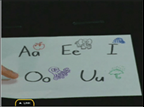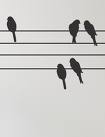Here’s a wonderful video that went viral this summer; it was recently sent to me again for the third time….I figure that means there are still folks who haven’t seen it. I smile every time I see it, so for those of you who haven’t viewed it yet, I’m including it here. The Sound of Music was a really big deal in my family when I was growing up, and when I saw this video for the first time, there were tears in my eyes. I just figured it was because I was tired from a long week, but my sister (who sent it to me) said she, too, felt her eyes fill up as she viewed it!
Archive Page 2
Music Ed and Do Re Mi
Published November 12, 2009 Making music , music education 1 CommentTags: do re me, do re mi, do re mi video, the sound of music
Music Education and Articulated Consonants
Published November 8, 2009 Making music , music education 1 CommentTags: articulation, articulation in singing, articulation in vocal music, neutral vowel, robert shaw, schwa, shadow vowel, terrace dynamics
 So….once your vowels are unified, it’s definitely time to move on to consonants…..
So….once your vowels are unified, it’s definitely time to move on to consonants…..
A reader left an excellent comment:
“Dear Michelle,
I have some issues with how to pronounce final consonants, because I learn different things from language/speech teachers than in music. For example, in speech/language sessions, I was taught not to dentalize or aspirate “d” or “t” endings, but it seems that this is what is taught in music.
As I am not a professional musician, I realize I may be missing something. Can you help out? Thanks.”
The way you articulate in vocal music is definitely different than you would in speech; it’s as if you must be fluid in two different languages. In making music, I strongly advocate putting a “shadow vowel” after an explosive consonant (like a D or a T). Robert Shaw said “Two consonants in succession (p/l, d/b, t/f, etc.) require a neutral “uh” vowel to be rhythmically inserted between them. Two words, one ending in a consonant and the next beginning with one, frequently require this neutral vowel (or “schwa,” or “shadow vowel”) for clarity of articulation”
I would further recommend having your choir put this “shadow vowel” on an explosive consonant (D, T, P, etc) that happens at the end of a phrase: In his treatment for choral singing , ” The Chorale Singers Cheat Sheet” , Sean Boulware says, “Explode consonants, don’t implode them. Audiences may love us for our vowels, but they respect (and pay) us for our consonants.” You must have your choir execute “shadow vowels” so that the text is clearly understood by the audience. Now, if the “schwa” is just too much, either have the choir as a whole back off a little bit, or just cut back on the number of choir members who are to perform the “shadow vowel“. Remember, you want to have enough so the choir is easily understood, but not so much that you turn off your listeners!
It’s a bit like “terrace dynamics“: even though that means to go from one dynamic level to another (piano to forte) with no graduations of volume (no diminuendos or crescendos), this was often accomplished in the Baroque era by suddenly eliminating instruments to achieve a quiter sound until it was time to play more loudly again.
Let’s Take A Break!
Published November 5, 2009 Making music , music education Leave a CommentTags: a capella group, Africa, Africa song, africa video, Perpetuum Jazzile, toto
Time now, I think, to take a break from all this talk of correct unison singing, vowels, consonants, yadda, yadda, yadda…..come with me now to “Africa” and hear Perpetuum Jazzile perform, making music with an astounding a capella rendition of rock band Toto’s song with an amazing duplication of a rain storm…this is nothing but pure enjoyment. Please take the time to watch this video; if you’ve never seen it, I promise you’ll enjoy it. If you’ve seen it before, I’m pretty sure you’ll want to see it again!
Music Education: How and when to pronounce “S”
Published November 1, 2009 music education , Uncategorized , unison singing Leave a CommentTags: elongated s, hissing, lisp, lisping, pronouncing S
 Oh, my……how and when to pronounce “S”, if done incorrectly, will make the smile of any trained singer listening to the choir’s performance turn into a grimace! We need to fix that problem immediately!
Oh, my……how and when to pronounce “S”, if done incorrectly, will make the smile of any trained singer listening to the choir’s performance turn into a grimace! We need to fix that problem immediately!
This requires more than just a conductor giving cues for ending a phrase; singing in and around an “S” requires group practice.
Many times, especially with an older group, I have found that an elongated “sss” is not uncommon; often I find that choir members who do this consistently are actually trying very hard to follow my directions. If you can isolate the offenders, I recommend asking for ‘help’ from them, and a few others, in this area by asking them to help out by “lisping” when an “S” comes along.
I myself always use a lisp when I am a choir member; in this way, I am not contributing to the problem! It helps that I actually had a mild lisp as a child; my youngest sister had one, too, and we went to the “speech teacher” at our elementary school. I was able to overcome my problem pretty easily (turns out I was “lazy”…Me! Can you believe it? Maybe that’s why I am such a stickler now…)
This helps with elongated “S”, but it’s up to you as the conductor to make sure that your choir holds off on closing their syllable; they’ll need to close their “S” all at the same time to avoid any “hisssssing” that might result from individuals closing to pronounce the “S” at different times.
Next time, a nice change of pace for us…don’t miss this video!
Music Education: Avoid sloppy consonant combos
Published October 25, 2009 music education 2 CommentsTags: consonant combinations, consonant combos, consonants, I will praise your name, lazy singing
 More on singing in unison….How would you handle these combinations?
More on singing in unison….How would you handle these combinations?
- 1. “I will praise Your name”
- 2. “Don’t you think I know”
Without proper direction, the first phrase is often sung with the words “praise Your” sounding blended together to almost rhyme with “treasure” or like our beloved Kelsey Grammer’s character “Frasier”.
It’s not difficult to pronounce a pure “Your” instead of a lazy “zshore”, and “praise” instead of “praiszh”; we just need to be aware and alert. Make certain to sing a definite “praizzze” and a separate “Your”. It will require a little extra effort at first, some awareness of articulation, but that bit of effort will definitely separate you from lazy singers and inarticulate choirs!
I’ll bet you already know where I’m going with the next phrase…..often sung as “Donchoo”, I always want to say “Gesundheit!” Have your choir practice clearly articulating the “T” in “Don’t” and a clear and separate “Y” afterwards for “you”.
‘Nuff said.
 What do you think? In my post ” Unison vowel production in Music Education” dated September 29, 2009, it has been suggested that perhaps I should demonstrate via video….comments are encouraged!
What do you think? In my post ” Unison vowel production in Music Education” dated September 29, 2009, it has been suggested that perhaps I should demonstrate via video….comments are encouraged!
Music Education: The Diphthong
Published October 19, 2009 music education 16 CommentsTags: choir, choral singing, diphthong, dipthong, unison singing, vowels
 A diphthong is two different vowel sounds that “glide” together, as in the case of the words cow (CAH-oo), eye (AH-ee), and my personal favorite, light (LAH-eet). Admit it, you’re practicing those words right now, aren’t you?! I knew it!
A diphthong is two different vowel sounds that “glide” together, as in the case of the words cow (CAH-oo), eye (AH-ee), and my personal favorite, light (LAH-eet). Admit it, you’re practicing those words right now, aren’t you?! I knew it!
Diphthongs present an easily remedied problem for unison singing. I mentioned earlier that unification of vowel sounds is crucial in choral singing, initially more important than making sure consonants are articulated. Right now is not the time to discuss breath control; to be sure, it plays an important role in the formation of vowels, but we’ll talk about that later.
To the unintiated, giving the second portion of a diphthong equal time (or more, depending on the length of the note) to the first vowel sound is very common.
Let’s take the word “light” (it is my favorite diphthong, after all). All too often, it is sung as “lah-eeeeeeeeeeet“. It’s a simple fix: everytime a word containing a diphthong is sung, concentrate on the first vowel sound: “laaaaaah” keep it pure and then, just as the duration of the note comes to an end, just hint at the second vowel sound: “LAAAAH-eet“. As a matter of fact, you might even direct your choir to ignore the second part of the diphthong altogether, and go directly to the consonant without it. Hence, “light” now becomes “laaaaaaht“. Your audience will certainly hear the word “light“, and your choir will have a nice, unified tone.
Remember just “hint” at the second part of a diphthong, and a very messy phrase will instantly clean up very well.
Ooh, by the way, never, NEVER sing a diphthong as two separate vowel sounds when the word is sung in two or more pitches; keep the first vowel pure over the slurred notes, and then just hint (or ignore – up to you) at the end. A great example is the word “Hour”; too often it is sung “Ah – wer” over two notes.
Next time: Avoiding sloppy consonant combos! See you then.
Thanks to all the supportive comments below!
Unison vowel production in Music Education
Published September 29, 2009 music education Leave a CommentTags: Jan Bickel, unison singing, vowel production, vowels
 I have been through many exercises for unison vowel production, and the best I have found was taught to me by my own vocal coach, Dr.Jan E. Bickel, D.M.A at Saint Xavier University in Chicago. She gave it to me as an excellent way to practice a smooth phrase:
I have been through many exercises for unison vowel production, and the best I have found was taught to me by my own vocal coach, Dr.Jan E. Bickel, D.M.A at Saint Xavier University in Chicago. She gave it to me as an excellent way to practice a smooth phrase:
Take the phrase we used last time, “In the land of the living, I will walk with God all my days.”
- Take away the consonants, and now you are left with: “I e a o e i i, i i a i o a y a” (In the land of the living, I will walk with God all my days).
- Have the choir pronounce the vowel sounds as they appear in the phrase (no diphthongs): i uh a uh uh i ee, ah i aw i o aw ah A (In thuh land uhv thuh liveeng, Ah will wawk with God awll mah daze)
OK, get ready for mutiny….this takes a little time to master; visual handouts for the choir, or even the vowel sounds written on the board are essential; but what results!
- Now have the choir sing only the vowels on their correct pitches and then have them connect the vowels to each other, sing in a very legato manner to produce a smooth phrase.
- Finally, have them put the consonants back in (they’ll be soooo relieved), but lightly! Just touch the consonants.
This is a wonderful way to get your choir to produce a lovely, smooth, truly unison phrase. This same exercise is helpful for unlocking the breath.
….more later!
Music Education: Now the vowels….
Published September 25, 2009 music education Leave a CommentTags: unison singing, vowel production, vowels
 Now that we’ve got the choir taking breaths simultaneously and completing phrases before taking the next breath, it’s time to move on to vowels.
Now that we’ve got the choir taking breaths simultaneously and completing phrases before taking the next breath, it’s time to move on to vowels.
Forming a unison vowel sound is harder than you think; before you even attempt to ask the choir to “enunciate”, you’d do well to make sure everyone’s vowel sounds are homogenous. The world we live in today is multicultural; the days of everybody in a community producing the same accent are over….besides, any trained singer will tell you that a spoken vowel is indeed produced differently when it is sung. This student of the voice has learned to produce vowels, and can lead their choir in simple vowel exercises. Be sure not to skip or be slack in this…remember, unison singing is far more than just all the voices of the choir singing the same part !
A wonderful exercise next time……
Music Education and Birdie Notation
Published September 21, 2009 Making music , music education Leave a CommentTags: birds on a wire, Jarbas Agnelli, music appreciation, musical notation
 Ha! Take that, Twitter!
Ha! Take that, Twitter!
There was a commercial on TV not too long ago where a composer, having a bad time with his work at the piano, looked out the window and saw birds sitting on wires. They were positioned just so; their little birdie bodies looked like musical notation on a staff. Remember it?
Well, here’s a little treat for you…a composer actually did it! Click on this link: Birdie Notation to view this video and see what the composer came up with.
Well, Jarbas Agnelli is certainly not the first to try making music in that way, but it’s fun to see and hear someone’s efforts on an old music education technique. Don’t pass up reading the comments…they’re a hoot!
I would love to hear from you about this….go on, give it a try! It’s an excellent assignment to give your music appreciation class.
Comments